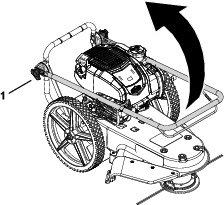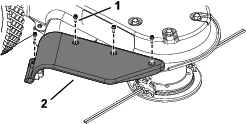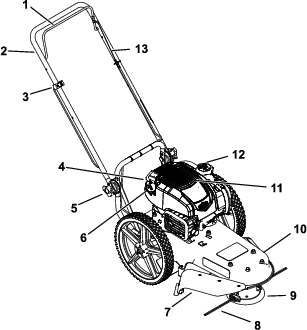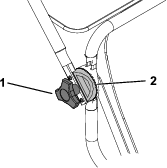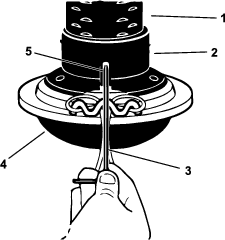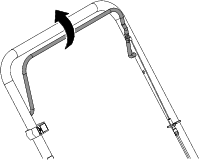Maintenance
Maintenance Safety
-
Shut off the machine and wait for all moving parts to stop before you leave the operator’s position. Allow the machine to cool before adjusting, fueling, unclogging, servicing, cleaning, or storing it.
-
Disconnect the spark-plug wire from the spark plug before performing any maintenance procedure.
-
Never tamper with safety devices. Check their proper operation regularly.
-
Keep all nuts, bolts and screws tight to ensure that the machine is in safe working condition.
-
Replace a faulty muffler.
-
Tipping the machine may cause the fuel to leak. Fuel is flammable and explosive, and can cause personal injury. Run the engine dry or remove the fuel with a hand pump; never siphon the fuel.
-
Inspect the machine regularly and replace worn or damaged parts. Ensure that parts are not bent, damaged, or loose.
-
To ensure optimum performance of the machine, use only genuine Toro replacement parts and accessories. Replacement parts and accessories made by other manufacturers could be dangerous, and such use could void the product warranty.
Recommended Maintenance Schedule(s)
| Maintenance Service Interval | Maintenance Procedure |
|---|---|
| Before each use or daily |
|
| Every 25 hours |
|
| Before storage |
|
| Yearly |
|
Important: Refer to your engine manual for additional maintenance procedures.
Pre-Maintenance Procedures
Preparing for Maintenance
-
Move the machine to a level surface, shut off the engine, and wait for all moving parts to stop.
-
Disconnect the spark-plug wire from the spark plug.
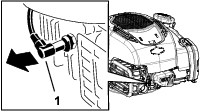
-
After performing the maintenance procedure(s), connect the spark-plug wire to the spark plug.
Important: Before tipping the machine to change the oil or replace the mower line, allow the fuel tank to run dry through normal usage. If you must tip the machine prior to running out of fuel, use a hand fuel pump to remove the fuel. Always tip the machine onto its side, with the dipstick down.
Engine Maintenance
Servicing the Air Filter
| Maintenance Service Interval | Maintenance Procedure |
|---|---|
| Every 25 hours |
|
| Yearly |
|
-
Unclip the top of the air-filter cover.
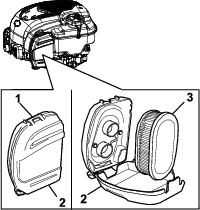
-
Remove the air filter.
-
Inspect the air filter.
Note: If the air filter is excessively dirty, replace it with a new filter. Otherwise, gently tap the air filter on a hard surface to loosen debris.
-
Install the air filter.
-
Use the clip to install the air-filter cover.
Changing the Engine Oil
| Maintenance Service Interval | Maintenance Procedure |
|---|---|
| Yearly |
|
Changing the engine oil is not required, but if you want to change the oil, use the following procedure.
Note: Run the engine a few minutes before changing the oil to warm it. Warm oil flows better and carries more contaminants.
| Engine oil capacity | 0.44 L (15 fl oz)* |
| Oil viscosity | SAE 30 or SAE 10W-30 detergent oil |
| API service classification | SJ or higher |
*There is residual oil in the crankcase after you drain the oil. Do not pour the entire capacity of oil into the crankcase. Fill the crankcase with oil as directed in the following steps.
-
Move the machine to a level surface.
-
Refer to Preparing for Maintenance.
-
Remove the dipstick by rotating the cap counterclockwise and pulling it out.
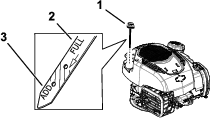
-
Tip the machine onto its side (so that the air filter is up) to drain the used oil from the oil-fill tube.

-
After draining the used oil, return the machine to the operating position.
-
Carefully pour about 3/4 of the engine capacity of oil into the oil-fill tube.
-
Wait 3 minutes for the oil to settle in the engine.
-
Wipe the dipstick clean with a clean cloth.
-
Insert the dipstick into the oil-fill tube, then remove the dipstick.
-
Read the oil level on the dipstick.
-
If the oil level on the dipstick is too low, carefully pour a small amount of oil into the oil-fill tube, wait 3 minutes, and repeat steps 8 through 10 until the oil level on the dipstick is correct.
-
If the oil level on the dipstick is too high, drain the excess oil until the oil level on the dipstick is correct.
Important: If the oil level in the engine is too low or too high and you run the engine, you may damage the engine.
-
-
Install the dipstick into the oil-fill tube securely.
-
Recycle the used oil properly.
Servicing the Spark Plug
Ensure that the air gap between the center and side electrodes is correct before installing the spark plug.
Use a spark plug wrench for removing and installing the spark plug(s) and a gapping tool/feeler gauge to check and adjust the air gap. Install a new spark plug(s) if necessary.
Type: Champion RN9YC or equivalent
Air gap: 0.75 mm (0.03 inch)
Removing the Spark Plug
-
Disconnect the spark-plug wire from the spark plug.

-
Clean around the spark plugs to prevent dirt from entering the engine and potentially causing damage.
-
Remove the spark plug.
Checking the Spark Plug
Important: Do not clean the spark plug(s). Always replace the spark plug(s) when it has a black coating, worn electrodes, an oily film, or cracks.
If you see light brown or gray on the insulator, the engine is operating properly. A black coating on the insulator usually means the air cleaner is dirty.
Set the gap to 0.75 mm (0.03 inch).
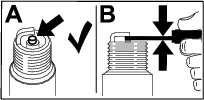
Installing the Spark Plug
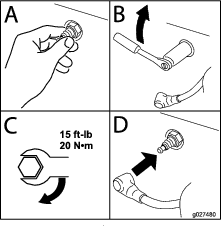
Drive System Maintenance
Removing and Installing the Wheels
| Maintenance Service Interval | Maintenance Procedure |
|---|---|
| Every 25 hours |
|
Remove and install the wheels as shown.
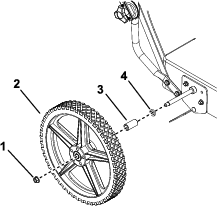
Replacing the Drive Belt
-
Remove the 2 fasteners securing the rear of the shield to the mower housing.

-
Remove the 4 fasteners securing the front of the shield and mower head to the mower housing.
-
Raise the front of the mower housing, loosen the mounting bolt on the drive pulley, and remove the “V” pulley from the idler bracket.
Important: Do not bend the belt guides.
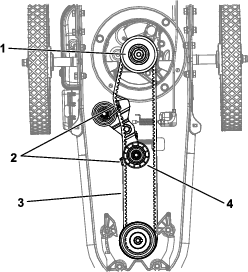
-
Remove the drive belt and install a new one.
-
Install the “V” pulley to the idler bracket.
-
Tighten the mounting bolt on the drive pulley.
-
Secure the mower head and the shield (Figure 19).
Adjusting the Drive Belt Tension
| Maintenance Service Interval | Maintenance Procedure |
|---|
Maintain proper belt tension to improve machine performance. Engage the drive lever and ensure that the spring extends 3 to 6 mm (1/8 to 1/4 inch). If it does not, adjust the belt tension.
Note: You may hear a short buzzing sound after releasing the engagement lever while using the machine. This is normal and is caused by the teeth of the cogged belt contacting the wire belt guide to stop rotation. You do not need to adjust the belt tension for this.
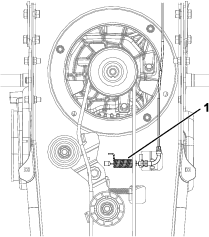
-
Loosen the upper jam nut on the adjustment cable.

-
Tighten the lower jam nut in 3 mm (1/8 inch) increments.
Note: A higher number of barrel-nut threads below the bracket increases the tension on the belt.
Important: Do not overadjust the tension.
-
Engage the drive lever and verify that the spring extends 3 to 6 mm (1/8 to 1/4 inch); adjust the jam nut again as needed.
-
Tighten the bottom jam nut.
-
If the mower still does not properly engage after adjusting the cable, adjust the jam nut for the second cable under the mower deck.
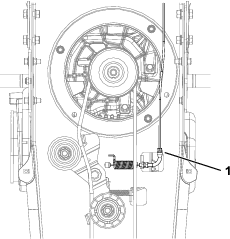
Mower Maintenance
Replacing the Mower Line
| Maintenance Service Interval | Maintenance Procedure |
|---|---|
| Before each use or daily |
|
Use a 4 mm (0.155 inch diameter) mower line, with a length of 55 cm (21-1/2 inches).
Important: Do not allow the line lengths to vary more than 2.5 cm (1 inch). Otherwise, the mower head may not be balanced and vibrate during operation.
Note: Keep the mower line moist to extend its life, maintain flexibility, and ease replacement. Store extra line in water.
-
Remove the worn mower line from the line retainer.
-
Cut new mower line to 55 cm (21-1/2 inches) or using the length guide (Figure 24) as follows:
-
Place 1 end of the line at 1 mark on the shield.
-
Bend the line along the raised portion of the shield to the second mark.
-
Cut the line at the second mark.
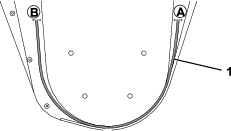
-
-
Thread the ends of the new mower line through the outer loops (Figure 25).
-
Cross the ends over the line retainer and threat them through the center hole.
-
Ensure that the ends of the line are even.
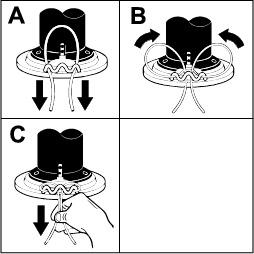
Cleaning
Removing Debris from the Machine
| Maintenance Service Interval | Maintenance Procedure |
|---|---|
| Before each use or daily |
|
Regular cleaning and washing increases the lifespan of the machine. Clean the machine directly after use.
Check before cleaning that the fuel tank cap is properly in place to avoid getting water in the tank.
Important: You can wash the machine with mild detergent and water. Do not pressure-wash the machine. Avoid excessive use of water, especially near the engine.
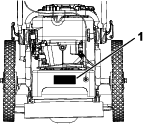

 , which means Caution, Warning,
or Danger—personal safety instruction. Failure to comply with
these instructions may result in personal injury.
, which means Caution, Warning,
or Danger—personal safety instruction. Failure to comply with
these instructions may result in personal injury.



